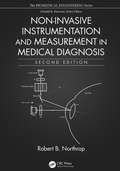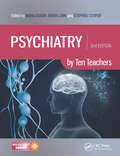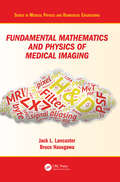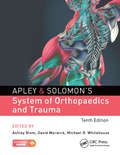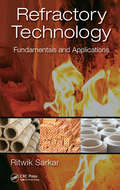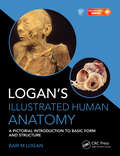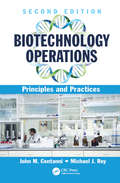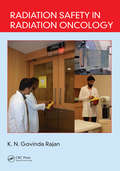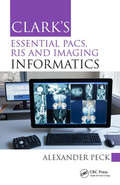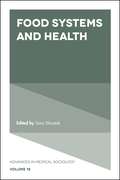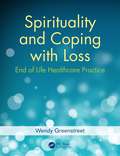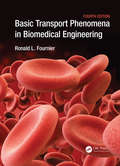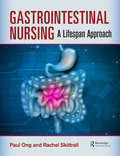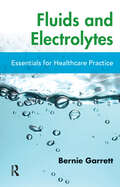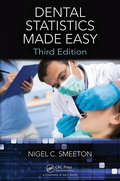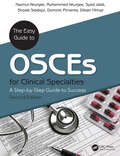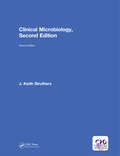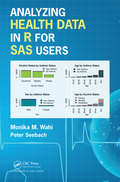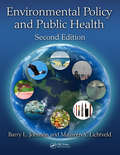- Table View
- List View
Non-Invasive Instrumentation and Measurement in Medical Diagnosis (Biomedical Engineering)
by Robert B. NorthropNon-Invasive Instrumentation and Measurement in Medical Diagnosis, Second Edition discusses NIMD as a rapidly growing, interdisciplinary field. The contents within this second edition text is derived from Professor Robert B. Northrop’s experience teaching for over 35 years in the Biomedical Engineering Department at the University of Connecticut. The text focusses on the instruments and procedures which are used for non-invasive medical diagnosis and therapy, highlighting why NIMD is the preferred procedure, whenever possible, to avoid the risks and expenses associated with surgically opening the body surface. This second edition also covers a wide spectrum of NIMD topics including: x-ray bone densitometry by the DEXA method; tissue fluorescence spectroscopy; optical interferometric measurement of nanometer tissue displacements; laser Doppler velocimetry; pulse oximetry; and applications of Raman spectroscopy in detecting cancer, to name a few. This book is intended for use in an introductory classroom course on Non-Invasive Medical Instrumentation and Measurements taken by juniors, seniors, and graduate students in Biomedical Engineering. It will also serve as a reference book for medical students and other health professionals intrigued by the topic. Practicing physicians, nurses, physicists, and biophysicists interested in learning state of the art techniques in this critical field will also find this text valuable. Non-Invasive Instrumentation and Measurement in Medical Diagnosis, Second Edition concludes with an expansive index, bibliography, as well as a comprehensive glossary for future reference and reading.
Psychiatry by Ten Teachers
by Nisha Dogra Brian Lunn Stephen CooperPsychiatry by Ten Teachers follows the highly-praised and successful ‘Ten Teachers’ tradition of providing the key information in a chosen specialty as required by the medical undergraduate, junior doctor and trainee GP, written by ten respected experts in the field. With medical students closely involved in the text’s development from the outset the text focuses on what the medical student and junior really need to know, with a clear rationale for the inclusion of every topic discussed at a level appropriate for the inexperienced, and will be of value to their future career whatever field they ultimately decide to specialize in. Completely up to date, this revised second edition encourages students and recently qualified doctors to get the most out of their psychiatry and community attachments, without overwhelming them with unnecessary detail. In line with the core curriculum recommended by the Royal College of Psychiatry, useful tips and advice ensure this is much more than a standard introduction to the subject, encouraging additional reading, supporting critical thinking and bringing exam success.
Fundamental Mathematics and Physics of Medical Imaging (Series in Medical Physics and Biomedical Engineering)
by Jack Lancaster Bruce HasegawaAuthored by a leading educator, this book teaches the fundamental mathematics and physics concepts associated with medical imaging systems. Going beyond mere description of imaging modalities, this book delves into the mechanisms of image formation and image quality common to all imaging systems: contrast mechanisms, noise, and spatial and temporal resolution, making it an important reference for medical physicists and biomedical engineering students. This is an extensively revised new edition of The Physics of Medical X-Ray Imaging by Bruce Hasegawa (Medical Physics Publishing, 1991), and includes a wide range of modalities such as X-ray CT, MRI and SPECT.
Apley & Solomon�s System of Orthopaedics and Trauma
by Ashley Blom David Warwick Michael WhitehouseNow in its Tenth Edition and in continuous publication since 1959, Apley & Solomon's System of Orthopaedics and Trauma is one of the world's leading textbooks of orthopaedic surgery. Relied upon by generations of orthopaedic trainees the book remains true to the teaching principles of the late Alan Apley and his successor Professor Louis Solomon. This new edition is fully revised and updated under the leadership of new editors. It retains the familiar 'Apley' philosophy and structure, and is divided into three major sections: General Orthopaedics, Regional Orthopaedics and Trauma, thus enabling readers to gain the knowledge they need for their lifetime learning.
Refractory Technology: Fundamentals and Applications
by Ritwik SarkarThis book provides a basic understanding of refractories. This includes the fundamentals of refractory technology supported by phase diagrams as well as detailing the prominent applications of these essential industrial materials. This book covers all the facets of refractory technology, starting from classification, properties, standard specifications, details of the conventional shaped refractories, including relevant phase diagrams & application areas and also the details of unshaped refractories including various classifications, bonding, additives and their applications.
Logan's Illustrated Human Anatomy
by Bari M. LoganThis concise illustrated volume presents a pictorial guide to human anatomy through the meticulous dissections of Bari Logan, assembled during his long career as a distinguished prosector, and representing an unrivalled collection of superb photographic images. Illustrations are fully labelled, and accompanied by brief clinical notes to provide additional guidance for the student. Material covering anatomical preparation and cadaver preservation, orientation and planes of section, the bones, muscles and cranial nerves and an extensive glossary provides supplemental detail. The book will be a convenient photographic companion to all core textbooks of anatomy and ideal during exam preparation.
Biotechnology Operations: Principles and Practices, Second Edition
by John M. Centanni Michael J. RoyThis book describes seven areas in the field of biotechnology operations as practiced by biopharmaceutical firms and nonprofit institutions. Revisions focus upon changes that have occurred in several areas over the past six years, with emphasis on regulatory, biomanufacturing, clinical and technical information, along with processes and guidlines that have added to the discipline. Examples are increased for new technical fields such as cell and tissue engineering. Further, illustrations or figures are added to each chapter to emphasize particular points.
Radiation Safety in Radiation Oncology
by K. N. Govinda RajanThe proposed book aims to explain the basic principles, concepts and regulations behind radiation protection and their application in the field of radiation oncology practice. This book will be useful to all those students, teachers and practicing professionals involved in the field of radiation oncology.
Clark's Essential PACS, RIS and Imaging Informatics (Clark's Companion Essential Guides)
by Alexander PeckImaging informatics is a complex and historically rapidly changing field, knowledge of which is central to the practice of all imaging specialists. This convenient pocket guide provides the foundations of knowledge in informatics, allowing radiographers in training and in practice, assistant practitioners and other allied health professionals to understand, use and develop more efficient ways of imaging that will in turn deliver improved patient care.
Food Systems and Health (Advances in Medical Sociology #18)
by Sara Shostak Brea L. PerryIn recent years, the ways in which food is produced, distributed, and consumed have emerged as prominent health and social issues. With rising concern about rates of obesity, food systems have attracted the attention of state actors, leading to both innovative and controversial public health interventions, such as citywide soda bans, “veggie prescription” initiatives, and farm-to-school programs. At the same time, social movement activism has emerged focused on issues related to food and health, including movements for food justice, food safety, farm worker’s rights, and community control of land for agricultural production. Meanwhile, many individuals and families struggle to obtain food that is affordable, accessible, and meaningfully connected to their cultures. Volume 18 of Advances in Medical Sociology brings cutting-edge sociological research to bear on these multiple dimensions of food systems and their impacts on individual and population health. This volume will highlight how food systems matter for health policy, health politics, and the lived experiences and life chances of individuals and communities.
Spirituality and Coping with Loss: End of Life Healthcare Practice
by Wendy GreenstreetSpirituality and Coping with Loss: End of Life Healthcare Practice describes a research study that reflects nurses’ experience of the nature of loss encountered in end of life care settings as well as the ways in which spirituality is a resource in coping in these situations. Key findings indicate how nurses’ spiritual development impacts their proficiency in spiritual care. These findings will be of interest to nurses and nurse educators as well as other healthcare professionals.
Basic Transport Phenomena in Biomedical Engineering
by Ronald L. FournierThis will be a substantial revision of a good selling text for upper division/first graduate courses in biomedical transport phenomena, offered in many departments of biomedical and chemical engineering. Each chapter will be updated accordingly, with new problems and examples incorporated where appropriate. A particular emphasis will be on new information related to tissue engineering and organ regeneration. A key new feature will be the inclusion of complete solutions within the body of the text, rather than in a separate solutions manual. Also, Matlab will be incorporated for the first time with this Fourth Edition.
Gastrointestinal Nursing: A Lifespan Approach
by Paul Ong Rachel SkittrallDisorders of the gastrointestinal tract make up some of the most common illnesses experienced across the lifespan affecting individuals in infancy, childhood and adulthood. This essential guide to the gastrointestinal system will enable nurses and allied health professionals to apply principles of anatomy and physiology to clinical practice. Taking a practical and evidence-based approach, each chapter explores associated anatomy, function and abnormalities. Chapters use selected pathology and associated pathophysiology, from across the lifespan, to support understanding of how disorders can disrupt the development and function of the gastrointestinal tract. The accessible writing style and full colour illustrations make this an ideal introduction for students and professionals new to gastrointestinal care.
Fluids and Electrolytes: Essentials for Healthcare Practice
by Bernard M. GarrettFluids and Electrolytes: Essentials for Healthcare Practice is designed to give a solid understanding of fluid and electrolyte physiology and its implications for practice, including acid-base balance and intravenous (IV) therapy, in a concise and easily understandable format. Chapters incorporate physiological, developmental and practical aspects, highlighting some of the key issues that arise from childhood to old age. This accessible text is presented with clear graphical representations of key processes, numerous tables and contains interesting facts to explore some common myths about human fluid and electrolyte physiology. A valuable resource for healthcare students, this book also provides a strong comprehensive overview for practitioners, nurses, physiotherapists and paramedics.
Dental Statistics Made Easy
by Nigel C. SmeetonThis essential textbook presents the basics of dental statistics in an accessible way, combining explanation in non-technical language with key messages, practical examples, suggestions for further reading and exercises complete with detailed solutions. There is an emphasis on the principles and application of statistics without the use of algebra. The statistical material is strongly rooted in practical examples drawn from a wide range of journal articles representing both dental health care delivery and clinical dentistry. The perspective is international, with papers drawn from a variety of settings around the world. Many articles are recent and report contemporary developments in dental care. The intended audience includes dental students and practitioners, those engaged in dental research and other health care professionals. For students and tutors, it covers the undergraduate curriculum, and the exercises and solutions make it ideal for course use. For practitioners and researchers it provides the first principles of study design, accessing the dental literature, and the preparation and publication of original dental research.
Data Analysis for the Life Sciences with R
by Rafael A. Irizarry Michael I. LoveThis book covers several of the statistical concepts and data analytic skills needed to succeed in data-driven life science research. The authors proceed from relatively basic concepts related to computed p-values to advanced topics related to analyzing highthroughput data. They include the R code that performs this analysis and connect the lines of code to the statistical and mathematical concepts explained.
Preparing for International Health Experiences: A Practical Guide
by Akshaya Neil AryaAt some point in their careers, many health professionals and students wish to engage in overseas work. Learning from other systems, people and cultures is invaluable and in some cases life changing. This book is a unique resource that offers necessary insights into making the most of the experience, from pre-departure training through to return orientation. It provides information on navigating the legalities and bureaucracies of international medical training and gives insights into cultural and language competencies, including how to be ethical and deferential in the exchange of situational knowledge. Preparing for International Health Experiences is a must-read for any healthcare student considering volunteering, doing mission or practical work abroad. It covers specific medical professions from paediatrics to surgery, and allied disciplines such as dentistry and nursing. Its practical tips and consideration of ethical issues will be valued by readers of different levels and experience.
The Easy Guide to OSCEs for Specialties: A Step-by-Step Guide to Success, Second Edition
by Nazmul Akunjee Muhammed Akunjee Syed Jalali Shoaib Siddiqui Dominic Pimenta Dilsan YilmazThis second edition of the highly successful Easy Guide to OSCEs for Clinical Specialties provides a comprehensive yet succinct resource to get you through each clinical rotation, as well as the Final exam. Compiled by recently qualified doctors who have experienced the new OSCE system first hand, the book covers over 80 OSCE examination stations in a wide range of different subjects. Brand new to this edition are chapters on Psychiatry, non-accidental injury in children, and an ‘On the Wards’ section covering both Anaesthetics and Palliative Care. All management suggestions are updated in line with NICE guidance and evidence-base, and new time-saving, student friendly mnemonics have been added to make the book even more user-friendly. This book will ease the already burdensome workload of medical students, and help them pass their OSCEs to become junior doctors competent in a wide range of different skills in medical fields.
Clinical Microbiology
by J. Keith StruthersThis concise, beautifully illustrated book provides a convenient introduction to the basic science of medical microbiology and how this relates to clinical practice. Expanded from the prize-winning first edition to cover virology and parasitology in addition to bacteriology, this second editions explains the essentials of microbial infection and continues to provide a sound basis for developing logical diagnostic and management strategies, including the critical area of antibiotic usage. Section One focuses on the clinical with chapters centred around infections of the organ systems, while full coverage of the scientific aspects underpinning microbial disease follows in Section Two.
McMinn's Concise Human Anatomy
by David Heylings Stephen W. Carmichael Samuel John Leinster Janak SaadaFocusing on the essentials, McMinn's Concise Human Anatomy is a convenient, portable guide and revision aid. The clear, jargon-free text is supported by high-quality, labelled photographs of cadaver dissections and surface anatomy, radiological images captured using the latest technologies and explanatory line diagrams, all redrawn for this edition. Providing full explanations of difficult anatomical relationships, and highlighting features of clinical significance throughout, this second edition remains an invaluable guide for students of anatomy across the medical and health sciences, and a handy reference for the busy clinician.
EMQs in Obstetrics and Gynaecology: Pt. 1, MCQs and Key Concepts (MasterPass)
by Marwan Habiba Andrea Akkad Justin KonjeThis work features a Foreword by David Taylor, Vice Dean, Leicester Medical School. "This book is the first to assist students with a new format of testing knowledge and clinical skills, i.e., the extended matching question. I am delighted my colleagues here in Leicester, where undergraduate education is given the very highest priority, have found the time and energy to write this book. This book comprehensively tests a whole range of obstetrics and gynaecology and I congratulate them for it." - David Taylor, in the Foreword. This revision aid in Obstetrics and Gynaecology is based on the Extended Matching Question format (EMQ). It contains over 200 patient vignettes arranged in topic areas covering a broad range of themes and degrees of difficulty. It provides test EMQs and detailed answers at the completion of each section. "EMQs in Obstetrics and Gynaecology" is an indispensable study and revision aid for undergraduate medical students preparing for in-course assessment in obstetrics and gynaecology as well as final exams. It also provides a vital review for specialist trainees in obstetrics and gynaecology preparing to take postgraduate exams.
Practical Pharmaceutical Calculations
by David Wright Michael BonnerUnderstanding practical pharmaceutical calculations is essential for healthcare professionals. Even simple errors in calculation can have serious - and possibly fatal - consequences. Fully revised and updated, with entirely new chapters and a focus on basic arithmetic, this best-selling practical guide begins by explaining simple units of measurements and expressions of concentration, followed by demonstrations of how straight-forward calculations can be used to estimate individual patient dosages. At the end of each chapter there are self assessment calculations, with fully worked answers - ideal for revision and self-assessment. With the book and free downloads you can always have the guide on hand when you need it most.
Analyzing Health Data in R for SAS Users
by Monika Maya Wahi Peter SeebachAnalyzing Health Data in R for SAS Users is aimed at helping health data analysts who use SAS accomplish some of the same tasks in R. It is targeted to public health students and professionals who have a background in biostatistics and SAS software, but are new to R. For professors, it is useful as a textbook for a descriptive or regression modeling class, as it uses a publicly-available dataset for examples, and provides exercises at the end of each chapter. For students and public health professionals, not only is it a gentle introduction to R, but it can serve as a guide to developing the results for a research report using R software. Features: Gives examples in both SAS and R Demonstrates descriptive statistics as well as linear and logistic regression Provides exercise questions and answers at the end of each chapter Uses examples from the publicly available dataset, Behavioral Risk Factor Surveillance System (BRFSS) 2014 data Guides the reader on producing a health analysis that could be published as a research report Gives an example of hypothesis-driven data analysis Provides examples of plots with a color insert
Donaldsons' Essential Public Health
by Liam J. Donaldson Paul RutterDonaldsons’ Essential Public Health has been in continuous print for 35 years, evolving through successive editions. This unrivalled record of success for a textbook of public health shows the enduring appeal of its content, style, and accessibility to generations of students and practitioners. For many of today’s national and global public health leaders, the book was their guide as they began their careers, their benchmark as they passed their examinations and professional accreditation, and remains their companion as a source of reference and refreshed knowledge for teaching and practice. The book brings together, in one volume, the main health problems experienced by populations and by the key groups within them, the strategies for promoting health and preventing disease, the principles and applications of epidemiology, the main themes of health policy, and a description of health service provision. This fourth edition marks the biggest change to the book in 20 years. For the first time it sets each key subject area in a global health context, whilst retaining its traditional strength in covering population health for the United Kingdom. New and revised chapters for this edition include: Health in a changing world Communicable diseases Non-communicable diseases Social determinants of health Quality and safety of healthcare Mental health Disability Health in later life Environment and health History of public health The content is wide-ranging and written in an accessible and engaging style. It covers topics as diverse as: the story of the 2014 Ebola virus outbreak in West Africa; the elements of tobacco control policy; the health impact of climate change; the global health organisational architecture; the concept of health; the new paradigm of public mental health; the biological pathways that link to the health effects of social deprivation; the ideal of universal health coverage; the essentials of immunisation; the basis of healthy ageing; the historical events that led to the germ theory of disease and the Victorian sanitary revolution. This new edition is essential reading for all undergraduate and postgraduate students of public health, medicine, nursing, health policy, social science, and public sector management. Those embarking on a career in public health will find it of great value throughout their professional life. The book is also an extremely useful resource for established practitioners in primary care, doctors, senior nurses, health system managers, healthcare policy makers, civil servants in ministries of health, and members of boards of health organisations.
Environmental Policy and Public Health
by Barry L. Johnson Maureen Y. LichtveldAs with the first edition, this second edition describes how environmental health policies are developed, the statutes and other policies that have evolved to address public health concerns associated with specific environmental hazards, and the public health foundations of the policies. It lays out policies for what is considered the major environmental physical hazards to human health. Specifically, the authors describe hazards from air, water, food, hazardous substances, and wastes. To this list the authors have added the additional concerns from climate change, tobacco products, genetically-modified organisms, environment-related diseases, energy production, biodiversity and species endangerment, and the built environment. And as with the first edition, histories of policymaking for specific environmental hazards are portrayed. This edition differs from its antecedent in three significant themes. Global perspectives are added to chapters that describe specific environmental hazards, e.g., air pollution policies in China and India. Also there is the material on the consequences of environmental hazards on both human and ecosystem health. Additionally readers are provided with information about interventions that policymakers and individuals can consider in mitigating or preventing specific environmental hazards.
